How Tribeca Became Tribeca
The History of Tribeca Buildings database—compiled from Tom Miller’s posts at Daytonian in Manhattan—has six more entries on the properties below. (Click the address to read the full text.) If you enjoy these, and you will, then you should definitely check out his website, which also has write-ups about buildings all over the island. And don’t miss his book, Seeking New York: The Stories Behind the Historic Architecture of Manhattan—One Building at a Time.
··················
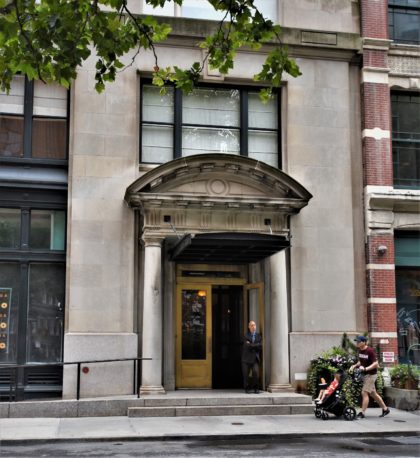 166 DUANE
166 DUANE
A nightmare occurred in the State’s Sanitation Department medical facilities in January, 1985, when a pipe froze and broke, spraying raw sewage throughout the clinic. On January 24, the Health Department declared the space “unfit for human habitation.” Health Commissioner Dr. David J. Sencer explained the clinic was unfit because there was no drinkable water, “several floors are flooded with raw sewage due to broken waste lines,” and “severe, noxious and objectionable odors are present.” It was a serious problem for days, preventing the medical treatment and examination of hundreds of sanitation workers.
··················
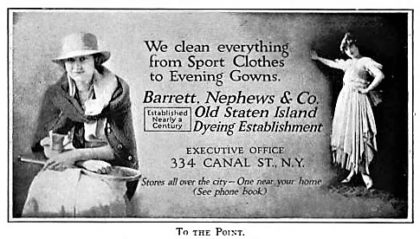 334 CANAL
334 CANAL
A small fire that broke out in the building on May 31, 1895, did not cause damage to it nor to the tenants’ factories or stock; but it ruined a police officer’s career and reputation. Officer Francis J. Clarke had been on the force 18 years. The day before, Memorial Day, he had gone to Calvary Cemetery with his Grand Army Post to lay flowers on the graves of soldiers. The day was very hot and Clarke suffered heat exhaustion. Nevertheless, he showed up for work at 8:00 the following morning, although he complained of not feeling well. When the call of fire at No. 334 arrive around 10:00, he answered it. After helping search for the cause of the alarm, he went outside and sat down on the sidewalk. Another officer, Michael F. McLaughlin, asked what was wrong. “I ain’t very well, Mac; I am very sick,” he reportedly answered. After McLaughlin brought him a glass of water, Clarke felt he was well enough to resume duty. He walked through No. 334 and out onto Lispenard Street, where he again had to sit on the pavement. By now firefighters had arrived and somehow Clarke’s brother had heard that there was a sick policeman in the store. Knowing his brother had been ill the day before, he rushed to the scene. Court transcripts documented that “his brother recognized him, ran out, and brought him a glass of whiskey.” He said “Here, Frank, take this and it will bring you around all right.” Clarke returned to the station house, too sick to go home. His brother’s good intentions landed him in police court, faced with multiple charges including intoxication on the job. On August 10, 1895, The Sun reported, “Patrolman Francis J. Clark [sic] of the Leonard street station was found guilty of being under the influence of liquor and dismissed from the force.”
··················
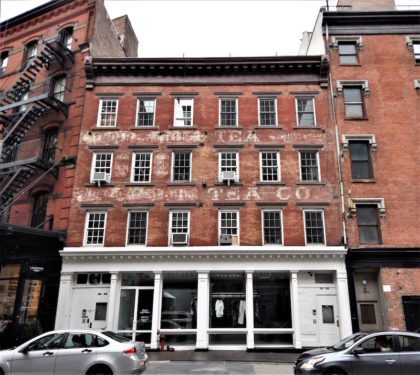 188-190 DUANE
188-190 DUANE
In the 21st century, when exotic foods reach markets around the globe within hours, it can be difficult to imagine the excitement caused when tropical fruits or foods from the West or South became available to New Yorkers. On August 13, 1895, The New York Times ran a front-page headline reading, “PEACHES NOW IN MARKET.” The article’s reporter went to No. 190 Duane Street to interview R. W. Dixon about the sensation. He gushed on about the fruit, saying in part, “New-York really cannot get too many first-class peaches. We have a deep love for peaches, and we are bound to get them if such a thing is possible. The rich class like the big, red-cheeked peaches that seem to have stored up and condensed sunshine, and it gets them by paying fancy prices. But there are some smaller, unpretentious looking peaches that are of just as good flavor and even finer substance that the poorer classes have learned to value.”
··················
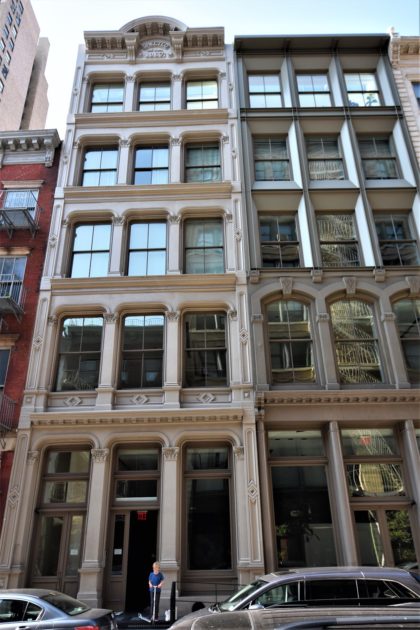 54 LISPENARD
54 LISPENARD
The building next door at No. 52 had been completed the same year as No. 54 and was also five stories tall, but a 1937 fire had left a two-story stub. In 2002, with Tribeca’s old loft buildings being converted to galleries, restaurants and upscale housing, the owners sought to demolish the little building and erect a five-story apartment building. The plans were shot down by the Landmarks Preservation Commission. The owners’ architects, Studio JS2, went back to the drawing board and came up with a design that would connect Nos. 52 and 54 and add a two-story addition above. The plans received what The Tribeca Trib called “a scathing rejection.” LPC Commissioner Diana Chapin said, “This is very bland.” A mutually acceptable compromise was finally achieved in an unapologetically modern, yet handsomely harmonizing three-story addition to No. 52, completed in 2017. While the combined structures share the address of No. 52 today, they maintain their separate personalities. Amazingly, other than replacement windows, the 1868 storefront of No. 54 is virtually intact.
··················
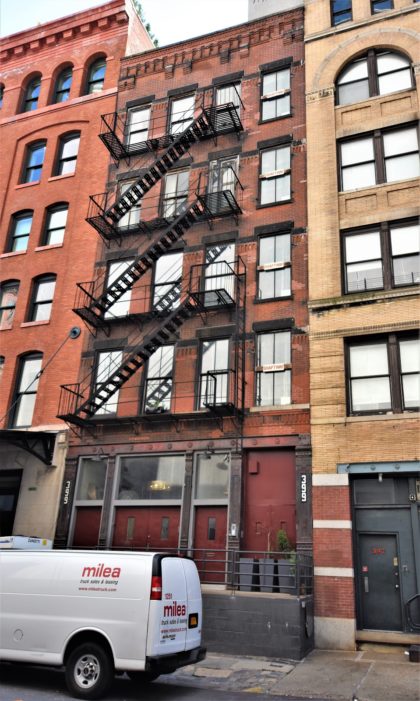 399 WASHINGTON
399 WASHINGTON
In March, 1933, the building would get a long-term tenant, Steinhardt & Kelly, with an amazing background. Joseph H. Steinhardt was born in 1854 in Tauberbischopsheim, Germany, where his parents ran a small shoe and leather store. The New York Times reported decades later, “Wonderful tales reached the family of the fortunes to be gathered in the United States, and at 13 the boy crossed the ocean to obtain his share.” The teen, however, was obstinate and strong-willed. That resulted in his being kicked out of the house of the relative where he was living. With no money and little command of English, he worked briefly as a newsboy, then was hired by a newspaper editor as a night-time messenger on the condition that he would go to school during the day. (He didn’t.) Eventually a truckman asked him to roll barrels of apples on the fruit pier. When he was finished, Joseph was given a bag of apples as payment. He ate five during the day while he went door-to-door selling the others, netting 50 cents. He suddenly realized how he could make money. Before too long, he advanced to bananas, and by the time he was a young man had saved enough to buy a pushcart. But he encroached upon the territory of a young Irish vendor and daily the two battled. The Times said, “Day after day the German and the Irishman abused each other until the former suddenly suggested: ‘Let’s cut this out and be partners.’ Thus was created the firm of Steinway & Kelly.” The newspaper said, “The partners started their joint business with a horse and wagon, developed a house-to-house trade with families, added hotels, and finally a step of great important—gained entrance to the business of supplying ships.” The firm was among the chief operators in opening up the farm regions of the West and Northwest. Kelly died in the early 1920s, followed by Steinhardt’s death on December 10, 1926. Steinhardt & Kelly, Inc. was doing more than $15 million in business a year at the time.
··················
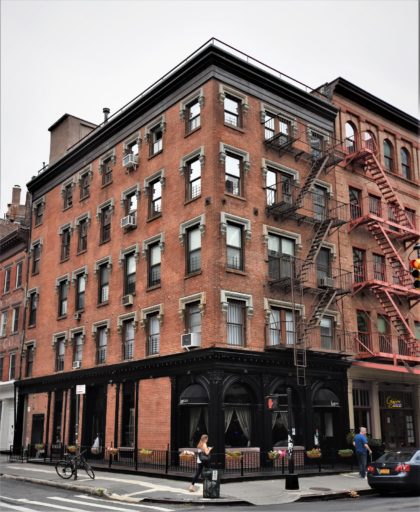 190A DUANE
190A DUANE
Importer Bartolome B. Blanco demolished the brick building on the southeast corner of Duane and Greenwich Streets and, in 1867, began construction of a substantial loft and store edifice. Although the store fronted Greenwich Street, the building originally took the address of 192 Duane Street, where the entrance to the lofts was centered along the 59-foot length. […] By 1891, the storefront was using the address No. 323 Greenwich Street. Confusion no doubt resulted, since the building next door already had that same address. […] Around 1925, the Greenwich Street address problem had been solved: Butter and eggs merchants Jonas Gewirtz & Son listed its address as 323A Greenwich Street. […] Today the store where produce and dairy products were sold for nearly a century and a half is home to an Italian restaurant. And to make the tangle in addresses even more confusing, it uses the address of 190-A Duane Street.
··················













